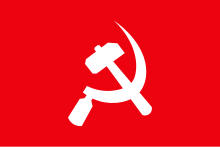
| Part of a series on |
| Maoism |
|---|
 |
| Part of a series on |
| Communism |
|---|
 |
|
|
Naxalism is the communist ideology of the Naxalites (or Naxals), a grouping of political and insurgent groups from India. It is influenced by Maoist political sentiment and ideology.
Inspired by Maoism, Charu Majumdar wrote the Historic Eight Documents, which became the basis of Naxalism. Majumdar, Kanu Sanyal, and Jangal Santhal formed a faction of the Communist Party of India (Marxist) that called for a protracted people's war. The Naxalite–Maoist insurgency started after a 1967 uprising in the village of Naxalbari, West Bengal. The ideology takes its name from the village. After the uprising, Sanyal established the Communist Party of India (Marxist–Leninist). Majumdar's writings became popular in urban areas. As students in Calcutta began to join the Naxalite movement, Majumdar shifted the ideology's focus beyond rural areas. The Naxalites splintered into various groups supportive of Maoist ideology. Under the Unlawful Activities (Prevention) Act of India (1967), some Naxalite organisations are designated as terrorist groups.
Naxalites believe that there is a class conflict between agricultural workers and landowners and that the Constitution of India lacks protections for tribal workers. This ideology has been popular among tribal people. Naxal groups have become authorities in areas they control, where they develop infrastructure, which gains support from residents. Naxalites have recruited youths, particularly those aligned with the working class. Naxalite feminists have said that leaders of Naxalite groups have committed violence against women and sexual violence. Naxalite groups are funded by extorting profits from companies, especially mining companies, in areas they control. The illegal drug trade is another funding source.